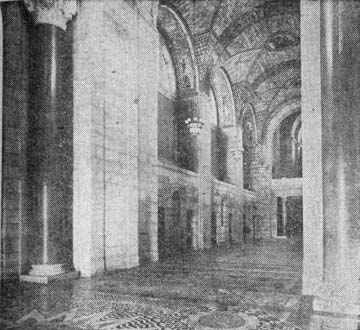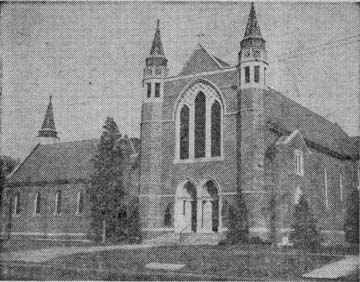

No. 39--Foyer of State Capitol Today we shall give you a few facts which include figures--the latter of which we have hitherto dealt out very stingily.
The lower part of the capitol is a square base, 437 feet each way, which conceals four inner courts formally landscaped. The tower reaches into the air 400 feet. The figure of the sower at the top is 20 feet tall and stands on a 12-foot pedestal--a shock of corn on a sheaf of wheat. The sower weighs about nine tons.
The four light colored pillars in the foyer are the largest single piece marble columns in this country. They weigh approximately sixteen tons each. The chandelier which hangs in the center of the building, is the largest bronze chandelier of its type in the world. Its bell part is a single piece of pure bronze, cast in New York City. The whole chandelier weighs 3,500 pounds. It is 112 feet from the floor to the ceiling from which the chandelier depends.
Gov. Samuel McKelvie broke ground for the new building April 15, 1922, with Marshal Joffre of France as guest of honor. Dedicatory exercises were held ten years later. The building cost $10,000,000 and is paid for.
Guides who tell many interesting facts about the capitol make daily trips thru the building, at 10:30, 2:00 and 3:30, excepting that on Sunday the 10:30 tour is omitted.

No. 40--First Presbyterian church, 17th and F. In 1863 Elder Young founded the town of Lancaster--to become Lincoln four years later on his own 80 acre tract, which cornered Luke Lavender's farm at what is now 14th and 0. The village was to extend from 14th to 7th and from 0 to Vine. As the far-sighted elder bent musingly over the white paper which represented the future town he saw a city strong in church life--and even predicted that it would some day be the capital of Nebraska. Another dream was of a female seminary--either to induce families with young ladies to come to the new town or to make prairie damsels into suitable wives and mothers for his churchly city. Hovering over the platted town his pencil finally came to rest at 9th and P as a site for the seminary.
Many of the lots into which his farm was ribboned he gave to county and school districts, money from the others went into the seminary, That institution burned in 1867, but Elder Young's dream of a city of churches was more enduring. Between 1866 and 1870 Congregational, Methodist, Presbyterian, Christian, Baptist and Catholic churches were organized and built. These were forerunners of present downtown churches. Lincoln now has about 80 places of worship.
The First Presbyterian church was organized April 4, 1869. Its first two buildings were supplanted in 1927 by the present beautiful structure, one of whose distinctions is having been planned by the late Ralph Adams Crams. Thus may it lay claim to special brotherhood with the Cathedral of St. John the Divine and St. Thomas' church of New York City.
|
|
|
|
© 2000, 2001 by Kathie Harrison, Ted & Carole Miller